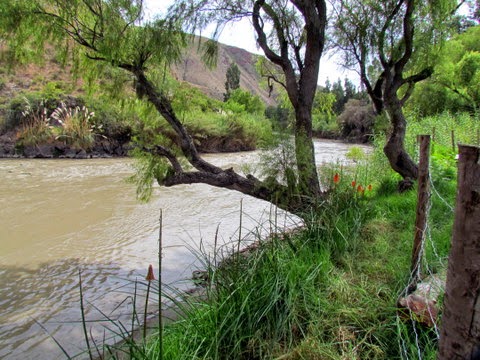I mentioned
yesterday that our hotel is in the Sacred Valley. This is what the town of Urubamba looks like
with the River by the same name running through it.
Our first
stop this morning was Ollantaytambo which is an Inca town that has been
continuously occupied since Inca times.
We walked the narrow cobble stone streets which are lined with walls
built by the Incas in the 1300s with canals with rushing water that they
designed for different purposes—drinking water, washing, sewage.
This thatched roof is first seen from the street and outer wall.
Here’s what
it looks like from the courtyard.
Inside is
only one room—used for cooking, sleeping, eating.
And shared
with guinea pigs! See them on the floor
on the right above. They live in the
house with everybody and are raised for food!
Every family has some. They are
not caged, but run around the floor eating, getting fat, producing more for the
family food.
Looking up
from the town streets, you can see an ancient Inca fort/temple which was
destroyed by the Spanish. Fortunately,
they didn’t find Machu Picchu.
Back in town, natives dress in colorful costumes and sit on the street to be photographed like this woman who is seated in front of one of the large stones placed by the Incas.
But then,
you can see others, like this little girl, sitting on a bench with her father
enjoying a treat while dressed in her beautiful outfit. She was not there to be photographed.
From here,
we drove to Chicheria to see a weaving demonstration. On our way,
we passed some beautiful farmland on rare flat spaces.
Here is a
local farmer working his land with a Peruvian tractor.
We also saw
rain falling in the mountains while we were enjoying blue skies and sun.
In
Chicheria, we went to a well-know artisan place known for its weaving where
museums buy articles because of their beauty and authenticity. We were shown the process from beginning to
end by girls dressed in their costumes.
First, water
is heated over a wood fire in a clay oven.
The wool has to be cleaned. A root is grated into hot water.
Which makes this soapy solution.
Hot water is
poured into pots and different plant sources are mixed to produce different
colored dyes.
The wool
that has been spun in yarn is dipped into the dye.
Beautiful
yarn is ready to be woven.
Yarn is then woven into fabric using a back-strap
loom.
We have done
all of this and it is not even noon yet!
Our next stop was to have lunch at a beautiful restaurant built like a hacienda called Tunupa. We went through a fabulous buffet, ate out on the terrace, and wandered through the gardens, down to the river, before leaving on our next adventure.
Our next stop was to have lunch at a beautiful restaurant built like a hacienda called Tunupa. We went through a fabulous buffet, ate out on the terrace, and wandered through the gardens, down to the river, before leaving on our next adventure.
Our final
stop for the day was an Inca Bar where home-made beer made out of maize, called
chicha, is served daily.
Mercedes is
the brewer here. She demonstrated the
process which takes 14 days from corn on the cob to finished chicha in the
glass.
I can hardly
believe that this is only the second day of this 22 day tour. I have experienced so much already.







































WOW! Wish I were with you!.... Love all the colors everywhere!
ReplyDeleteDid buy any of the loomed fabric?
What did you eat at the hacienda style restaurant?
Want more details!
Praying for wonderful experiences, safe travel, meeting colorful people, and lots of 'eye candy' to share with us!
Luvu
Kathy
Hi Gail! I am so excited to know you're on this wonderful journey. You are my hero!! Thanks for sharing the beautiful photos and the narrative. I look forward to traveling with you over the next 20+ days. Love and peace coming your way. Judy
ReplyDeleteIf I post twice...ooophs! As usual, your photos are wonderful! Full of color and people of all ages. I feel as if I'm there with you! Judy
ReplyDelete